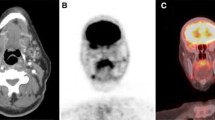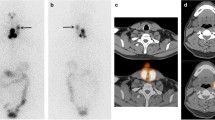Abstract
The usefulness of fluorine-18 fluorodeoxyglucose (FDG) positron emission tomography (PET) in differentiated thyroid cancer (DTC) has been demonstrated by many investigators, but in only a small number of studies have FDG-PET images been compared with those obtained using other non-iodine tumour-seeking radiopharmaceuticals. In most of the studies, planar imaging was performed for comparison using thallium-201 chloride or technetium-99m 2-methoxyisobutylisonitrile (99mTc-MIBI). Furthermore, FDG-PET studies were not always performed in the hypothyroid state with increased levels of thyroid stimulating hormone (TSH), which are known to increase FDG uptake by DTC. The aim of this study was to compare the ability of FDG-PET to detect metastatic DTC with that of 99mTc-MIBI whole-body single-photon emission tomography (SPET) and post-therapeutic iodine-131 scintigraphy, evaluated under TSH stimulation. Nineteen patients (8 men, 11 women; age range, 38–72 years, mean 60 years; 17 thyroidectomised and 2 inoperable patients following 131I ablation of the remaining thyroid tissue; 16 papillary and 3 follicular carcinomas) with metastatic DTC underwent FDG-PET whole-body scan (WBS) and 99mTc-MIBI SPET WBS at an interval of less than 1 week, followed by 131I therapy. The SPET images were reconstructed using the maximum likelihood expectation maximisation (ML-EM) method. All patients were hypothyroid at the time of each scan. 131I WBS was performed 3–5 days after oral administration of the therapeutic dose. A total of 32 lesions [10 lymph node (LN), 15 lung, 6 bone, 1 muscle] were diagnosed as metastases, as confirmed by histopathology and/or other imaging modalities (X-ray, US, CT, MRI, bone, 201Tl and 131I scans). FDG-PET, 99mTc-MIBI SPET and post-therapeutic 131I scintigraphy respectively revealed a total of 26 (81.3%), 20 (62.5%) and 22 (68.8%) lesions. These techniques respectively demonstrated nine (90.0%), eight (80.0%) and six (60.0%) LN metastases, and eleven (73.3%), seven (46.7%) and ten (66.7%) lung metastases. They each demonstrated five of the six bone metastases (83.3%). FDG-PET and 99mTc-MIBI SPET were positive in 17 (78.3%) and 14 (63.6%) of the 22 131I-positive lesions, respectively, and also in nine (90.0%) and six (60.0%) of the ten 131I-negative lesions, respectively. Three of the five 131I-positive and FDG-PET-negative lesions were miliary type lung metastases with a maximal nodular diameter of less than 10 mm. Comparison of FDG-PET with 99mTc-MIBI SPET revealed concordant results in 24 lesions, and discordant results in eight lesions (seven with positive FDG-PET alone and one with positive 99mTc-MIBI SPET alone). In conclusion: (a) even using whole-body SPET, FDG PET is superior to 99mTc-MIBI in terms of ability to detect metastases of DTC; (b) the higher sensitivity of FDG-PET compared with the previous studies could partly be due to increased serum TSH.



Similar content being viewed by others
References
Schlumberger MJ. Diagnostic follow-up of well-differentiated thyroid carcinoma: historical perspective and current status. J Endocrinol Invest 1999; 22 (11 suppl):3–7.
Shiga T, Tsukamoto E, Nakada K, Morita K, Kato T, Mabuchi M, Yoshinaga K, Katoh C, Kuge Y, Tamaki N. Comparison of18F-FDG, 131I-Na, and 201Tl in diagnosis of recurrent or metastatic thyroid carcinoma. J Nucl Med 2001; 42:414–419.
Grünwald F, Kälicke T, Feine U, Lietzenmayer R, Scheidhauer K, Dietlein M, Schober O, Lerch H, Brandt-Mainz K, Burchert W, Hiltermann G, Cremerius U, Biersack HJ. Fluorine-18 fluorodeoxyglucose positron emission tomography in the thyroid cancer: results of multicentre study. Eur J Nucl Med 1999; 26:1547–1552.
Grünwald F, Menzel C, Bender H, Palmedo H, Willkomm P, Ruhlmann J, Franckson T, Biersack HJ. Comparison of18FDG-PET with 131iodine and 99mTc-sestamibi scintigraphy in differentiated thyroid cancer. Thyroid 1997; 7:327–335.
Dietlein M, Scheidhauser K, Voth E, Theissen P, Schicha H. Follow-up of differentiated thyroid cancer: what is the value of FDG and sestamibi in the diagnostic algorithm? Nuklearmedizin 1998; 37:6–11.
Feine U, Lietzenmayer R, Hanke JP, Held J, Wöhrle H, Müller-Schauenburg W. Fluorine-18-FDG and iodine-131-iodine uptake in thyroid cancer. J Nucl Med 1996; 37:1468–1472.
Helal BO, Merlet P, Toubert ME, Franc B, Schvartz C, Gauthier-Koelesnikov H, Prigent A, Syrota A. Clinical impact of18F-FDG PET in thyroid carcinoma patients with elevated thyroglobulin levels and negative 131I scanning results after therapy. J Nucl Med 2001; 42:1464–1469.
Alnasfisi NS, Driedger AA, Coates G, Moote DJ, Raphael SJ. FDG PET of recurrent or metastatic131I-negative papillary thyroid carcinoma. J Nucl Med 2000; 41:1010–1015.
Schlüter B, Bohuslavizki KH, Beyer W, Plotkin M, Buchert R, Clausen M. Impact of FDG PET on patients with differentiated thyroid cancer who present with elevated thyroglobulin and negative131I scan. J Nucl Med 2001; 42:71–76.
Chung JK, So Y, Lee JS, Choi CW, Lim SM, Lee DS, Hong SW, Youn YK, Lee MC, Cho BY. Value of FDG PET in papillary thyroid carcinoma with negative131I whole-body scan. J Nucl Med 1999; 40:986–992.
Dietlein M, Scheidhauser K, Voth E, Theissen P, Schicha H. Fluorine-18 fluorodeoxyglucose positoron emission tomography and iodine-131 whole-body scintigraphy in the follow-up of differentiated thyroid cancer. Eur J Nucl Med 1997; 24:1342–1348.
Fridrich L, Messa C, Landoni C, Lucignani G, Moncayo R, Kendler D, Riccabona G, Fazio F. Whole-body scintigraphy with99mTc-MIBI, 18F-FDG and 131I in patients with metastatic thyroid carcinoma. Nucl Med Commun 1997; 18:3–9.
Moog F, Linke R, Manthey N, Tiling R, Knesewitsch P, Tatsch K, Hahn K. Influence of thyroid-stimulating hormone levels on uptake of FDG in recurrent and metastatic differentiated thyroid carcinoma. J Nucl Med 2000; 41:1989–1995.
Petrich T, Börner AR, Otto D, Hofmann M, Knapp WH. Influence of rhTSH on [18F]fluorodeoxyglucose uptake by differentiated thyroid carcinoma. Eur J Nucl Med Mol Imaging 2002; 29:641–647.
Wong CO, Dworkin HJ. Role of FDG PET in metastatic thyroid cancer. J Nucl Med 1999; 40:993–994.
Dadparvar S, Chevres A, Tulchinsky M, Krishna-Badrinath L, Khan AS, Slizofski WJ. Clinical utility of technetium-99m methoxyisobutylisonitrile imaging in differentiated thyroid carcinoma: comparison with thallium-201 and iodine-131 Na scintigraphy, and serum thyroglobulin quantitation. Eur J Nucl Med 1995; 22:1330–1338.
Mueller SP, Piotrowski B, Guth-Tougelides B, Reiners C. Technetium-99m MIBI and Tl-201 uptake in thyroid carcinoma [abstract]. J Nucl Med 1988; 29 (Suppl):854.
Miyamoto S, Kasagi K, Misaki T, Alam MS, Konishi J. Evaluation of technetium-99m-MIBI scintigraphy in metastatic differentiated thyroid carcinoma. J Nucl Med 1997; 38:352–356.
Alam MS, Kasagi K, Misaki T, Miyamoto S, Iwata M, Iida Y, Konishi J. Diagnostic value of technetium-99m methoxyisobutyl isonitrile (99mTc-MIBI) scintigraphy in detecting thyroid cancer metastases: a critical evaluation. Thyroid 1998; 8:1091–1110.
Lazar V, Bidart JM, Caillou B, Mahé C, Lacroix L, Filetti S, Schlumberger M. Expression of the Na+/I− symporter gene in human thyroid tumors: a comparison study with other thyroid-specific genes. J Clin Endocrinol Metab 1999; 84:3228–3234.
Grünwald F, Biersack HJ. FDG PET in thyroid cancer: thyroxine or not?. J Nucl Med 2000; 41:1996–1998.
Wang W, Larson SM, Fazzari M, Tickoo SK, Kolbert K, Sgouros G, Yeung H, Macapinlac H, Rosai J, Robbins RJ. Prognostic value of [18F]fluorodeoxyglucose positron emission tomographic scanning in patients with thyroid cancer. J Clin Endocrinol Metab 2000; 85:1107–1113.
Schlumberger M, Challeton C, Vathaire FD, Travagli JP, Gardet P, Lumbroso JD, Francese C, Fontaine F, Ricard M, Parmentier C. Radioactive iodine treatment and external radiotherapy for lung and bone metastases from thyroid carcinoma. J Nucl Med 1996; 37:598–605.
Acknowledgements
We sincerely thank Miss Yuko Ono for excellent technical and secretarial assistance.
Author information
Authors and Affiliations
Corresponding author
Rights and permissions
About this article
Cite this article
Iwata, M., Kasagi, K., Misaki, T. et al. Comparison of whole-body 18F-FDG PET, 99mTc-MIBI SPET, and post-therapeutic 131I-Na scintigraphy in the detection of metastatic thyroid cancer. Eur J Nucl Med Mol Imaging 31, 491–498 (2004). https://doi.org/10.1007/s00259-003-1403-y
Received:
Accepted:
Published:
Issue Date:
DOI: https://doi.org/10.1007/s00259-003-1403-y




